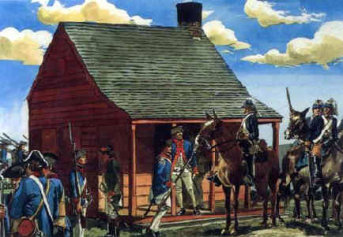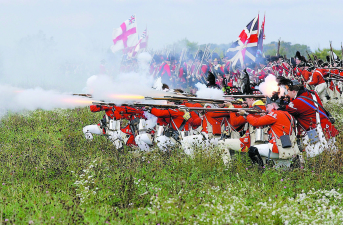Battle of Saratoga
The Story of the Battles of Saratoga

Above: The Neilson House in the American Camp served as the headquarters for Generals Benedict Arnold and Enoch Poor.
“…one of the Greatest battles that Ever was fought in Amarrca…”
Major Henry Dearborn
The Revolutionary War is enshrined in American memory as the beginning of a new nation born in freedom. In this memory the conflict was quick and easy, the adversaries are little more than cartoon-like tin soldiers whose brightly colored uniforms make them ideal targets for straight-shooting American frontiersmen.
In actuality, the very year of Independence was a time of many military disasters for the fledgling republic; the first year of its existence was almost its last. New York was the stage for much of the drama that unfolded.
During the summer of 1776, a powerful army under British General Sir William Howe invaded the New York City area. His professional troops defeated and outmaneuvered General George Washington’s less trained forces. An ill advised American invasion of Canada had come to an appalling end, its once confident regiments reduced to a barely disciplined mob beset by smallpox and pursuing British troops through the Lake Champlain Valley.

Above: Scene from a Re-enactment at the Saratoga Battlefield
As 1776 ended, the cause for American Independence seemed all but lost. It was true that Washington’s successful gamble at the battles of Trenton and Princeton kept hopes alive, but the British were still holding the initiative. Royal Garrisons held New York and its immediate environs, Newport, Rhode Island and Canada. Additionally the Royal Navy allowed the British to strike at will almost anywhere along the eastern seaboard.
In hopes of crushing the American rebellion before foreign powers might intervene, the British concocted a plan to invade New York from their base in Canada in 1777. Essentially, two armies would follow waterways into the Rebel territory, unite and capture Albany, New York. Once the town was in their possession, these British forces would open communications to the City of New York, and continue the campaign as ordered. It was believed that by capturing the Hudson River’s head of navigation (Albany) and already holding its mouth (the City of New York), the British could establish their control of the entire river. Control of the Hudson could sever New England-the hot bed of the rebellion-from the rest of the colonies.

Above: The Surrender of General Burgoyne at Saratoga, New York. 17 October 1777. Painting by John Trumbull and taken from the Microsoft Encarta Encyclopedia
The architect of the plan, General John Burgoyne, commanded the main thrust through the Lake Champlain valley. Although the invasion had some initial success with the capture of Fort Ticonderoga, the realities of untamed terrain soon slowed the British triumphant advance into an agonizing crawl. Worse for the British, a major column en route to seek supplies in Vermont was overrun, costing Burgoyne almost irreplaceable 1000 men. Hard on the heels of this disaster, Burgoyne’s contingent of Native Americans decided to leave, word came from the west that the second British column was stalled by the American controlled Fort Stanwix and that the main British army would not be operating near the city of New York. Although his plans were unraveling, Burgoyne refused to change his plans and collected enough supplies for a dash to Albany.
For the Americans, the British delays and defeats had bought them enough time to re-organize and reinforce their army. Under a new commander, General Horatio Gates, the American army established itself at a defensive position along the Hudson River called Bemis Heights. With fortifications on the flood plain and cannon on the heights, the position dominated all movement through the river valley. Burgoyne’s army was entirely dependent upon the river to haul their supplies, and the American defenses were an unavoidable and dangerous obstacle.
Learning of the Rebels’ position, Burgoyne attempted to move part of his army inland to avoid the danger posed by the American fortifications. On September 19th 1777, his columns collided with part of General Gates’ army near the abandoned farm of Loyalist John Freeman. During the long afternoon, the British were unable to maintain any initiative or momentum. Pinned in place, they suffered galling American gunfire as they strove to hold their lines. Late in the day, reinforcements of German auxiliary troops turned the tide for Burgoyne’s beleaguered forces. Although driven from the battlefield, the British had suffered heavy casualties and Gates’ army still blocked his move south to Albany.
General Burgoyne elected to hold what ground he had and fortify his encampment, hoping for assistance from the City of New York. On October 7th, with supplies running dangerously low and options running out, Burgoyne attempted another flanking move. The expedition was noticed by the Rebels who fell upon Burgoyne’s column. Through the fierce fighting the British and their allies were routed and driven back to their fortifications. At dusk, one position held by German troops, was overwhelmed by attacking Americans. Burgoyne had to withdraw to his inner works near the river and the following day tried to withdraw northward toward safety. Hampered by bad roads made worse by frigid downpours, the British retreat made only eight miles in two days to a small hamlet called Saratoga; Gates’ army followed and surrounded Burgoyne and his army. With no other option Burgoyne capitulated on 17 October 1777.
The American victory at Saratoga was a major turning point in the war for Independence, heartening the supporters of independence and convincing France to enter in the war as an ally of the fledgling United States. It would be French military assistance that would keep the rebel cause from collapse and tip the balance at Yorktown, Virginia in 1781 – winning America its ultimate victory as a free and independent nation. The war also would reach to nearly every quarter of the globe as Spain and the Netherlands would become involved. But more importantly ideals of the rebel Americans would be exported as well, inspiring people throughout the world with the hope of liberties and freedom.
The preceding information was provided by the staff at the Saratoga National Historical Park.



